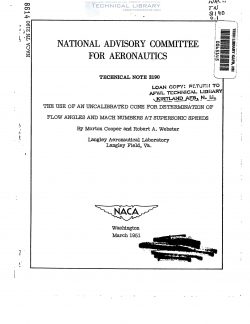naca-tn-2190
- Version
- 53 Downloads
- 1.45 MB File Size
- 1 File Count
- December 14, 2016 Create Date
- December 14, 2016 Last Updated
National Advisory Committee for Aeronautics, Technical Notes - The Use of an Uncalibrated Cone for Determination of Flow and Mach Numbers at Supersonic Speeds

A pressure-distribution investigationof a body of revolution has
been conducted in the Langley ll-- by 1L-foot supersonic tunnel at a Mach
number of 1.59 and a Reynolds number of 1.01; x 106 per foot. The data
over the forward part of the body have been analyzed to indicate the
accuracy with which an uncalibrated cone containing four static-pressure
orifices and one total-pressure orifice can be used as a Mach number and
flow-angle indicator at supersonic speeds'. The results show that, by a
simple averaging process, the free-stream Mach number for the present
tests was predicted within 0.01 up to incidence angles of about 8°.
Further increases in incidence resulted in the overestimation of the Mach
number by as much as 0.05 at an- angle of 16.100. The angle of attack
and the angle of yaw were predicted within 0.50 for various combinations
of pitch and yaw up to an angle of attack of 10°. In an installation
where the yaw was zero, the angle-of-attack prediction was improved to
within 0.30 in the angle-of—attack range from 6° to 114.0 by proper orien-
tation of the static orifices.
A comparison of the experimental pressure distributions over the
surface of the cone with various theoretical calculations indicated a
marked superiority of the theoretical calculations in which the presence
of the entropy singularity on the upper surface of the cone was considered.
During the past few years, appreciable effort has been expended
towards the development of a suitable means for determining the free-
stream Mach number and the pitch-yaw attitude of aircraft and missiles
at transonic and supersonic speeds.‘ Some of the initial efforts con-
cerned the determination of Mach number from pitot-static tubes and
also from airspeed systems using flush static-pressure orifices on
fuselages in regions relatively insensitive to flight attitude. The use
of pitot-static tubes is a natural consequence of low-speed investigations
and provides a simple means for determining the Mach number through the
complete subsonic and supersonic flight range. The use of flush static-
pressure orifices, although simple in principle, yields, in reality,
only an indication of the static pressure and requires an elaborate
calibration system. In either application, the methods are restricted
to the determination of the flight Mach number since no accurate indi-
cation of the pitch-yaw attitude is inherently possible from these systems.
| File | Action |
|---|---|
| naca-tn-2190 The Use of an Uncalibrated Cone for Determination of Flow and Mach Numbers at Supersonic Speeds.pdf | Download |
Comment On This Post